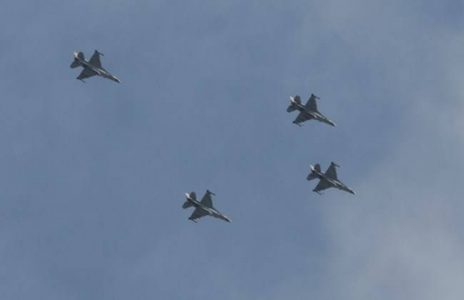
Israeli forces plan intensive strikes against Hamas tunnel network
The IDF said that it was planning “an intensive night” with plans to strike “new locations” of Hamas’s sprawling tunnel network in two other sections of the Gaza Strip that had yet to be hit over the past four nights, IDF Spokesman Brig.-Gen. Hidai Zilberman said Tuesday.
He made his comments after a terrorist mortar barrage targeted the Eshkol region in the northwestern Negev. Two Thai workers were killed and several civilians and a soldier were wounded.
At least 10 civilians were wounded, four of them seriously, following the barrage of more than 50 mortars earlier Tuesday. The two Thai workers died on their way to Soroka-University Medical Center in Beersheba.
A 19-year-old soldier was also wounded in his upper body by shrapnel when a mortar hit the Erez crossing, where his unit was assisting in transferring humanitarian aid shipments to the Gaza Strip. He was transferred to Barzilai Medical Center in Ashkelon in stable condition.
Israel had temporarily reopened the Kerem Shalom crossing to allow for the transfer of truckloads of fuel, medicine, animal feed and fuel tanks to the coastal enclave.
“The entry of the trucks was coordinated following the request of the international community and approved by the defense minister this morning,” the Coordinator of Government Activities in the Territories (COGAT) said, adding that following the mortar barrage, Kerem Shalom crossing was closed.
Dozens of rockets were launched at Israeli communities in the Gaza periphery and at Ashdod, Ashkelon and Beersheba.
Following the salvos, the IDF said it had struck an underground launch site and rocket launchers belonging to Hamas in al-Moazi refugee camp in the central part of the Gaza Strip and another two in its northern and southern areas.
Earlier in the day, the IDF said it had struck a Palestinian Islamic Jihad (PIJ) cell preparing to launch rockets toward Israel from central Gaza. It also bombed another 120 targets over the past 24 hours, including 10 rocket launchers.
The majority of the strikes were focused in the wealthy Rimal neighborhood of Gaza City, Zilberman said.
Despite calls for a ceasefire, Defense Minister Benny Gantz said the IDF has thousands of more targets left to strike.
“No person, area or neighborhood in Gaza is immune,” he said at a navy base in Ashdod. “We have thousands of more attack targets… The IDF has many plans to continue striking Hamas, and the fighting won’t stop until we bring about complete and long-term calm.”
“The international community also needs to understand that it was the Hamas terrorist group that opened fire and that is continuing to fire indiscriminately toward civilian populations, and it bears responsibility and is paying the price,” he added.
Gantz spoke to US Defense Secretary Lloyd Austin on Tuesday and told him Hamas continues to fire on civilians.
The IDF operation, which “has achieved significant military achievements in recent days,” will continue “with the aim of bringing long-term peace,” he said.
Prior to their conversation, senior members of Israel’s defense establishment had provided classified information to Pentagon officials showing that Hamas military activity had been carried out from the Jala office building that the IDF destroyed. The building housed the offices of the Associated Press and Al Jazeera.
Tuesday’s barrages came after a rare lull in the violence overnight, despite a threat by Hamas that it would fire on Tel Aviv should the IDF continue to strike residential areas, including high-rise buildings.
Since the beginning of the fighting, close to 3,500 rockets have been fired from the Gaza Strip toward Israel, with some 500 falling short and landing inside the coastal enclave.
Twelve 12 people in Israel have died since the beginning of the fighting, and more than 330 have been injured, Magen David Adom reported.
The military continued to carry out strikes against Hamas and PIJ targets overnight, including 10 to 12 multi-barrel rocket launchers, six of which were ready to be fired toward the Gush Dan region, the IDF told reporters on Tuesday morning.
A total of 65 launchers, which can fire between four and nine rockets within seconds, have been destroyed over the past three days, it said.
The IAF struck the “D” phase of Hamas’s Metro underground network, and 60 fighter jets struck 65 targets with 110 munitions, destroying some 10-15 km. of the network, the IDF said.
“We know the grid of the network underground and every entry shaft,” Zilberman said, adding that destroying the network pushes the Hamas operatives to act above ground.
Between 125 and 130 Hamas and 30 PIJ operatives have been killed since the beginning of the operation last week, he said. The Gaza Strip Health Ministry has reported the death toll at 200, including 59 children and 35 women, and another 1,300 have been injured.
The IDF also struck several residences of battalion and unit commanders, including the home belonging to the Gaza battalion commander who is responsible for firing rockets toward Ashkelon.
Meanwhile, on the northern border, six rockets were fired from Lebanese territory toward Israel by a Palestinian group. None of the rockets crossed into Israeli territory. The IDF responded with tank and artillery fire.
Source: JP





